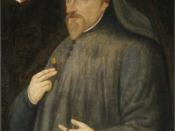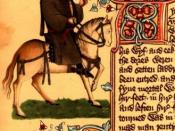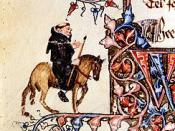Religion in England during the fourteenth century was a dominant part of society and people's lives. Through The Canterbury Tales by Geoffrey Chaucer, people can try to comprehend what the people of England were like and how they lived their daily lives. Now is where the corruption and foul people of the church come in to play in The Canterbury Tales there are many religious characters: Monk, Friar, Pardoner, Nun, Prioress - the list continues on. Chaucer tells readers about the characters and how they live corrupt, lavish, extravagant, fraudulent lifestyles. The vast majority of clergy members, according to Chaucer, were corrupt and untrue to their vows.
The first of these characters is the Monk; a man who one must remember has vowed to lead a life of poverty, chastity and obedience. It can immediately be seen that Chaucer is not partial to the Church and the clergy.
The first two lines set the scene for the portrait; Chaucer starts by telling the reader that the Monk outshines all other monks "a fair for the maistrie" (165), this at first appears complimentary, though when one reads on one discovers that this monk outshines the other monks in his negligence of his duty to God. This "exceptional" monk is in fact a gluttonous, self-centered man, who would rather concentrate on hunting, for he "lovede venerie" (166), and increasing his chances of a career promotion. He also appears to contradict all of the aforesaid vows, for example his 'venerie' is not only hunting, an indulgent pursuit of a man certainly not living in poverty and obedience, but it is also an image of wealth. Chaucer tells us that this monk is the owner of a fine horse and when he is riding passers-by can hear the chapel bells and...


